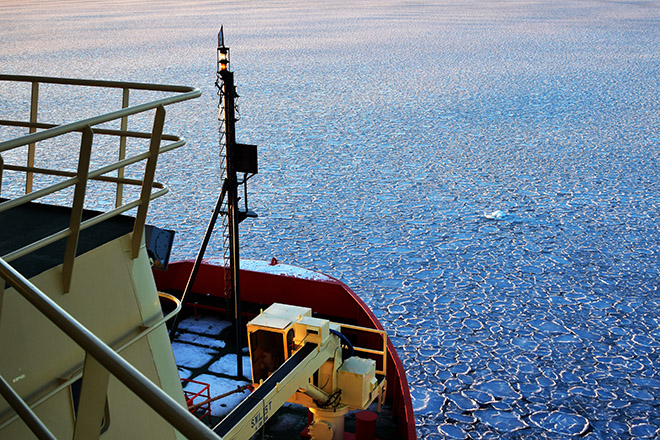Retreating Sea Ice is Transforming the Bransfield Strait
A month at the bottom of the world
 © 2016 The Pew Charitable Trusts
© 2016 The Pew Charitable TrustsThe research vessel icebreaker Nathaniel B. Palmer makes its way through pancake ice covering the Bransfield Strait.
This is the second in a series of dispatches by Ryan Dolan of The Pew Charitable Trusts’ global penguin conservation campaign, who has joined a team of Southern Ocean experts on a research expedition to the Antarctic—in the middle of winter.
Aug. 9, 2016—Bransfield Strait, Antarctica
We’re finally here in the Bransfield Strait, a place known to Antarctic aficionados for its concentration of wildlife. It is stunningly beautiful—in the distance, icebergs hundreds of feet higher than our vessel tower over the ocean’s surface. I will never forget the moment we encountered our first sea ice. I’d been hearing loud rumbles along the hull from inside the lab on board and could feel the ship vibrating. I ran to a porthole to look out and saw waves of pancake ice—large pieces of sea ice with rounded edges from rubbing against each other—gliding on the waves around us. For me, it marked our true arrival to the Antarctic and gave me a strange sense of comfort, like a blanket of ice was tucking us in for our Antarctic adventure.
Although we continue to encounter large pockets of sea ice, there are vast portions of the Scotia Sea and the Bransfield Strait that are uncharacteristically ice-free this winter season. For most of our journey, we have sailed wide open seas with only sporadic patches of young ice. This is bad news for an ecosystem adapted to winter sea ice coverage, but it means that we’ll be going farther south than this particular NOAA expedition has ever gone, to areas previously not accessible during these months. We are currently heading to the southern part of the Gerlache Strait, one of the most beautiful areas on the Antarctic Peninsula, where we hope to find Antarctic krill. And where there are krill, there are penguins, seals, and even whales. Fingers crossed!
Those of us on the Zoo Lab’s night shift are enjoying some downtime until we reach our next research station several hours away. We’ve only been on this ship for a matter of days, but civilization is so far beyond reach that it is as if it does not exist at all. This feels particularly true because I do not ever see the sun during my 12-hour shift—8 p.m. to 8 a.m. But during the limited hours of daylight, there is a lot to take in. So far I’ve seen many seabirds, including albatrosses, skuas, and a few species of petrel, that seem to float with no effort above the water’s surface. I’ve also seen a couple of brown blobs on the ice, which experts on the ship tell me were fur seals. And several of my shipmates have spotted whales. I’m keeping my eyes on the water in case one surfaces. To this point, most of the wildlife I’ve seen has been through a microscope lens in the miniature world of zooplankton that exists in the waters below. On board, a number of research projects are going on to determine how their underwater world is changing. I continue to be in awe of the fascinating research the crew is doing, and I’ll be sharing more about their work in the coming days.
In the meantime, don’t forget to follow me at Instagram and Twitter.
Ryan Dolan is an officer on The Pew Charitable Trusts' global penguin conservation campaign.







